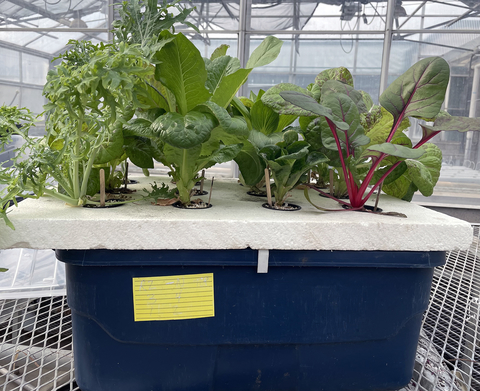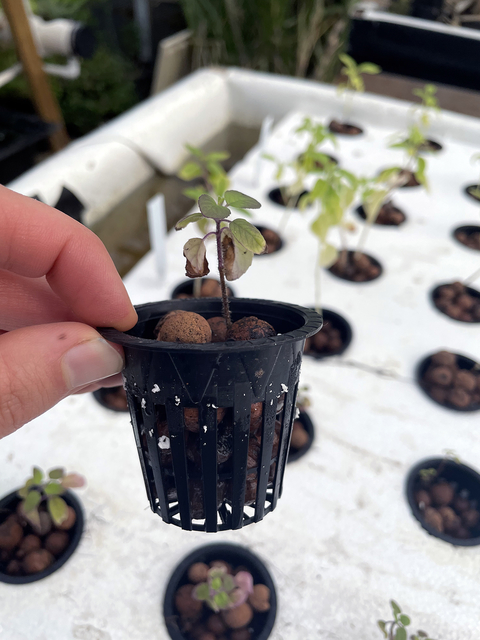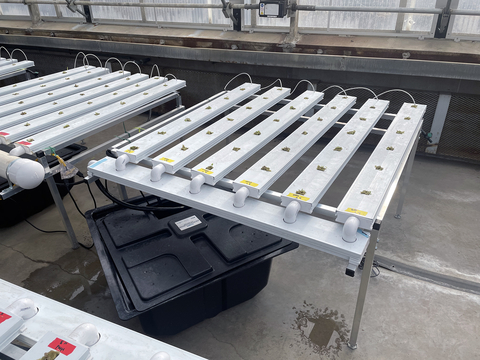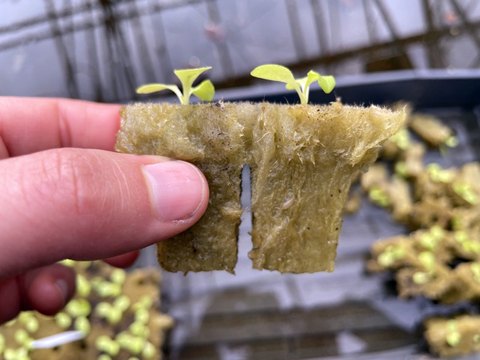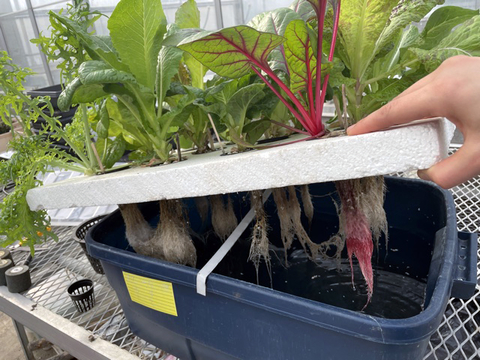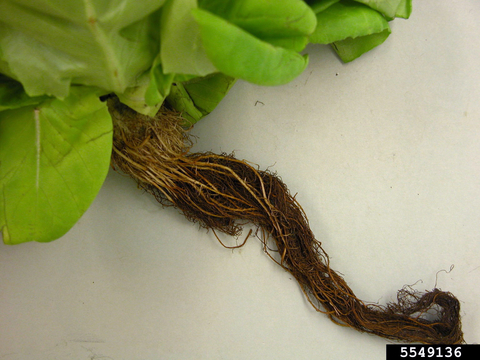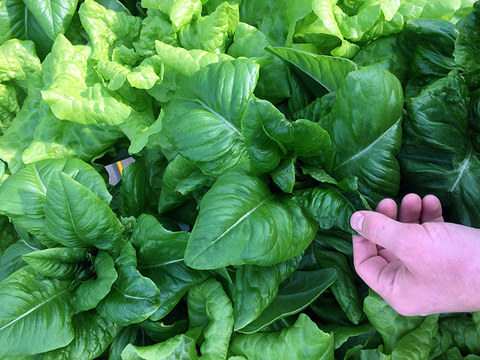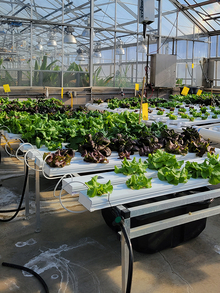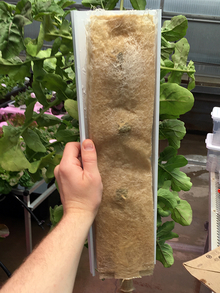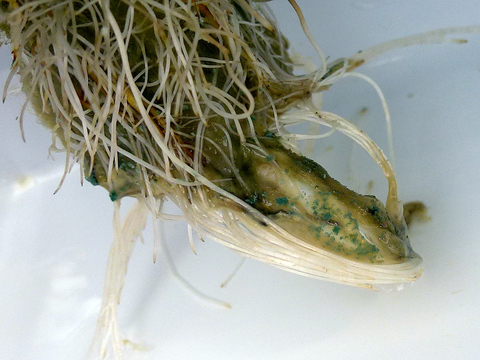A quick guide to hydroponics
- Hydroponics is a method of growing plants without soil.
- You can grow hydroponically all year long.
- Hydroponics uses less water than traditional soil-based systems.
- Hydroponic growing allows for faster growth and higher yields than traditional soil-based growing systems.
- To grow hydroponically, you need plants, a container, water, a way to anchor the plants, nutrients and a light source.
- It is possible to grow vegetables hydroponically both outdoors and indoors. If growing indoors, artificial lighting will help faster growth.
Grow greens, herbs, vegetables and fruit all year long
Hydroponics is a type of soilless gardening that can be done either indoors or outdoors. It’s a great option for people with little or no gardening space, or who want to grow herbs and vegetables through the winter.
Hydroponic gardening is space-efficient and takes less water than gardening in soil. Growing in water also means no weeds. With artificial lighting, you can grow hydroponically all year long, even in Minnesota.
Although almost anything can be grown hydroponically, short-season crops or crops that do not produce fruit such as herbs and leafy greens are great choices for indoor production in the winter.
In the summer, strawberries, tomatoes, cucumbers and peppers are all great choices. It’s becoming more common for commercial growers of these crops to grow hydroponically instead of in soil.
Basic components of hydroponic systems
The simplest hydroponic systems to use at home fall into a category of hydroponics called “Deep Water Culture.”
- Plants are suspended above a tank of water and the roots hang into the container where they absorb water and nutrients.
- This is the most common type of hydroponic system for small-scale growers such as people growing for their own use and school demonstration gardens.
- It is also the least expensive and easiest to maintain and expand.
You can buy premade deep water culture hydroponic systems, but it is more affordable and nearly as easy to build your own.
For this type of system, your container for holding water and plants can be as simple as a 5-gallon bucket or a plastic storage bin. Any kind of container that holds water will do for hydroponics, as long as it is clean and made of a material that is safe for food (a material that will not leach harmful chemicals into the water).
Consider the following when choosing a container for your hydroponic system:
Size
The size of the plants you’d like to grow should dictate the size of your container. For example, if you’d like to grow a tomato hydroponically, consider the size of the canopy of a mature tomato plant, and choose a container that is approximately the same size.
The seed packet should tell you how large the plant will be.
If you’d like to grow multiple things in one container such as multiple heads of lettuce, a wider container will be necessary.
Lid or flotation device
The container in your hydroponic system will hold the water and nutrients, but something needs to support the plant.
When using a bucket, the most common support structure for plants is simply the lid of the bucket with holes drilled through it for the plants.
If you do not have a lid, another common practice is to use extruded polystyrene (sheets of insulation). You can either rest the polystyrene sheets over the top of the container or float them directly on top of the water.
If you choose to float the sheets directly on the water, it’s a good idea to provide some extra support (such as PVC tubes) to hold the polystyrene sheet as the plants become heavier.
Cost, aesthetic appeal, and space efficiency
If you would like your hydroponic system to look more attractive than just a bucket, an easy solution is to build a frame around it such as the Hydroponic Salad Table.
If you’re hoping to expand your system to have multiple containers in use at the same time, you can increase space efficiency with adjustable wire shelves, with plastic totes or buckets on each shelf.
These additional factors are not necessary and will increase the cost, but can make your set-up more efficient and attractive.
A key component of any hydroponic system is the support structure for your plants.
The most common system for DIY hydroponics is the combination of net pots and a substrate.
- A net pot is simply a pot with holes or slits in the sides to allow the root system to reach the nutrient solution below.
- The net pot should only be partially submerged to allow the developing plant roots to get oxygen.
- Net pots come in a variety of sizes and styles to suit a diverse range of systems.
Rather than filling the net pots with soil, common substrates include perlite, hydroton, pumice, gravel, coconut coir and Rockwool.
The pros and cons of each substrate are listed in the table below. No matter which substrate you choose, soak it in water for 24 hours and change the water before transplanting your seedlings into it. This helps to remove dirt and debris, and in some cases can remove residues that can impact the pH of your system.
If you re-use your substrate, make sure to clean it and sanitize it before planting again to prevent pathogen build-up.
The list of substrates in the table is not comprehensive; new products are released regularly.
| Substrate | Explanation | Pros | Cons |
|---|---|---|---|
| Rockwool | Most popular medium; Superheated rock and chalk that is spun like wool | Comes in a variety of shapes, sizes | Not biodegradable |
| Retains oxygen well | Can irritate skin, eyes, and lungs | ||
| Pore spaces are a good size for root development | Alkaline - can impact the pH | ||
| Coconut coir | Coconut husk byproduct | Good water retention - keeps roots from becoming dehydrated | Variable product |
| Environmentally friendly | Some types of coir (bricks) must be rehydrated before use | ||
| Reusable (a few times) | |||
| Made of organic material - more potential for insects or pathogens | |||
| Hydroton / LECA | Lightweight expanded clay pebbles the size of marbles | Larger spaces between pebbles: more airflow and ease of root development | Limited water holding capacity (only a problem if you forget to water or let the water level drop) |
| Reusable | More expensive than other options | ||
| Easy to work with and clean | |||
| Perlite | Ore that has been heated in a kiln and puffed / expanded | Holds on to oxygen well | Non-renewable resource |
| Reusable (a few times) | Small particles are more prone to blockages - can accumulate algae and biofilms | ||
| Inexpensive | Can be harmful to fish - do not use in aquaponics | ||
| Can be too lightweight, causing it to float | |||
| Pumice | Porous volcanic rock | Available in multiple sizes; larger sizes allow for more airflow | May be hard to find pumice that is not chemically treated |
| Lightweight | Variable product: sharp edges can sometimes cause root damage to plants | ||
| No super-heating necessary; may be more sustainable than some of the other rock-based options | Can be too lightweight, causing it to float | ||
| Gravel | Small rock from a variety of sources | Inexpensive | Heavy |
| Drains well | Can impact the pH | ||
| Easy to work with and clean | Small particles are more prone to blockages - can accumulate algae and biofilms |
The net pot system needs to be supported in some way. The easiest way to do this is to drill net pot-sized holes in the top of your container. The hole should be large enough to fit the majority of the pot through it, but just small enough for the lip of the net pot to rest on top.
If your container does not have a lid, you can use an extruded polystyrene board (insulation boards) or a wide-lip basket. When using polystyrene, support the board from below by adding PVC tubes to the container. This way, the board can be elevated slightly above the water level, which becomes important as the plant roots begin to develop.
The simplest option for hydroponic lighting is to grow outdoors in the summer. This is a great option for people who have access to a balcony or patio with sun exposure.
For indoor hydroponics, supplemental lighting is almost always necessary. While you may find success growing plants indoors if you have a very sunny south-facing window, you will likely need artificial lights in the winter.
The most common types of lighting available to small-scale growers include LED and fluorescent bulbs. There are pros and cons to using each type.
| Types of grow lights | Pros | Cons |
|---|---|---|
| LED (light emitting diode) | Very energy efficient | Higher up-front cost than other bulbs |
| Long-lasting | ||
| Wide spectrum of light | ||
| Do not produce too much heat | ||
| Wide variety of styles and sizes | ||
| Fluorescent | Moderately energy efficient | Do not last as long |
| Cheaper up-front cost | Use more energy than LEDs | |
| Some only produce light in the blue-green spectrum, but others have a wider spectrum that includes red light; check label | ||
| Incandescent | Cheapest up-front cost | Inefficient |
| Do not last as long | ||
| High pressure sodium | Emit substantial light | Better suited to large-scale systems |
| Older technology | ||
| Release a lot of heat | ||
| Not all of the light is usable to plants (outside of plant-available spectrum) |
Regardless of the type of light you choose, consider the following factors:
Red vs. blue light:
The light spectrum includes colors ranging from red to blue; some light bulbs produce mostly blue light, some produce mainly red, and others produce a mix of blue and red light.
- While a balance of blue and red light is best for plant growth, you can get away with just blue light if you’re only growing leafy greens.
- Light from the red portion of the light spectrum helps plants to develop thicker stems, which are needed for producing flowers or fruit.
- In experiments with lettuce, less blue light results in more mild tasting lettuce with a flat texture; more blue light results in “spicier” lettuce with a curlier texture.
-
Check the specifications of your lightbulb to see what type of light it emits. Light bulbs marketed as “white light” or “full spectrum” will produce a balance of red and blue light.
Cost:
Consider the up-front cost as well as day to day costs to run your lighting system to determine whether it is worth it for you.
Example:
For a small hydroponics system with 1 or 2 5-gallon buckets, you would need a single 9-Watt LED grow light with a PPF of 16 micromoles per second ($15 plus $10 for a work light to mount the bulb).
LED lights have a lifespan of about 25,000 hours. If you run that light for 14 hours per day, every day of the year (5110 hours per year), it should last about 4 years and 10.5 months. For approximately 45,990 Watts of electricity per year (9 Watts x 5110 hours run time).
At an electricity cost of 12 cents per kilowatt hour (a common price in 2020), you can expect to pay about 45 cents per month or $5.44 per year in electricity. Add to that $15 every 5 years to replace the bulb.
More information about supplemental lighting.
Passive aeration (the Kratky method)
In a passive deep water system, the aeration is provided by the air gap above the water. This is why it’s important to only submerge the net pot partway as the seedlings grow, and why it’s important to keep the roots only 1/3 to 1/2 submerged once they start to develop beyond the net pot.
Active aeration
If using a single container, an airstone is the most common type of aeration device in hydroponics. An airstone is a synthetic “stone” full of pores. It is connected through tubing to an external pump. The pump pushes oxygen through the stone, which, due to its porous structure, releases the air as tiny bubbles. They are commonly used in aquariums and come in a wide variety of sizes and shapes.
Consider an airstone if you are growing multiple plants with different root lengths in the same container. If one plant’s roots are submerged more than half of their length to accommodate a shorter plant nearby, aeration will help to keep the water sufficiently oxygenated to prevent plant damage.
If you have many containers, it is more common to use a recirculating deep water culture (DWC) system. Containers are connected with tubing, and a large pump circulates oxygenated water between the containers and a reservoir. With this method, you can just pay attention to balancing the pH and nutrients in the reservoir vs. managing each container separately.
You can purchase prefabricated recirculating deep water culture systems from online retailers and hardware stores, but they tend to be costly for hobby growers. There are also some excellent DIY tutorials on YouTube if you prefer to build your own.
While deep water culture is by far the most simple hydroponic set-up, it is by no means the only option. The following methods are more common among commercial growers, but they can be adapted for smaller-scale systems as well.
All of the information listed above related to pots, substrates, and lighting still apply to these more advanced systems. The major downside of these more complex systems is that they rely on pumps and other mechanical parts. If there is a malfunction (such as a power outage), the plants cannot access water, and they can dry out quickly. Larger growers typically have generators as a back-up, but this is less practical for small-scale hydroponic gardeners.
The following is an overview of some of the most common advanced systems; it is not a comprehensive list, and there are variations to all of these systems.
Ebb and flow:
In an ebb and flow system, plants are grown in a tray with substrate. The water and nutrient solution are in a separate but connected reservoir.
- The growing tray either has a porous bottom, in which case it is placed directly above the nutrient reservoir, or it contains a drain, which connects via tubing back to the reservoir.
- Growers use pumps to pull the water from the reservoir into the tray where the plants are. It then slowly drains through the porous substrate, back into the reservoir.
- These systems are available as prefabricated units. They are sold online from hydroponics vendors and at hardware stores.
- They can also be made at home with basic materials such as buckets, plastic containers and plumbing supplies.
Nutrient film:
In a nutrient film system, plants are usually grown in channels or troughs. The idea is similar to deep water culture in that there is a constant stream of water available to the roots. The water is constantly moving and tends to be quite shallow.
- This type of system uses a reservoir for water and nutrients (such as a large plastic drum) and the water is pulled into the channels, usually with tubing and a pump.
- The channels are angled downwards to allow for water flow. When the water reaches the end it is recirculated to the reservoir.
- These can be purchased as premade units, or homemade with recycled gutters.
- This is an efficient system for larger-scale operations because it allows you to manage the water and nutrient solution from one central location.
Drip systems:
Drip systems are very similar to the nutrient film technique but, instead of having a continuous stream of water flowing through a trough or channel, the water flows through a hose system.
- The hose has holes spaced in accordance with your plants. This is essentially drip irrigation.
- Some drip systems have a trough or channel that allows excess water to flow back to the reservoir and others do not.
- This set-up is becoming increasingly common in high tunnels, where farmers grow tomatoes and strawberries in long, tubular bags filled with a substrate like coconut coir, and use hoses with holes or drip lines directly at the base of each plant.
Planting
Plant selection is key to successful hydroponic gardening. In order to choose a plant that will be successful in your system, consider how much light and heat you will have access to.
Plants that do well in hydroponic systems
All year long:
- Lettuce, herbs, and plants in the Brassica family, such as mustards and kale, grow well year-round in hydroponic systems.
- Other leafy greens such as amaranth and swiss chard can also work well.
- Look for seed companies with varieties identified as doing well in hydroponic systems.
Outdoors in the summer:
- Almost anything can be grown hydroponically outdoors in the summer. Tomatoes, cucumbers and strawberries are popular options.
- While it is possible to grow these plants indoors with supplemental heat and lighting, the amount of added heat and light would be cost-prohibitive for most gardeners.
- If you choose to grow these heat-loving plants hydroponically, look for terms like “grows well in pots” or “container variety” when selecting a variety.
Start seeds separately and then transplant them into the hydroponic system after germination.
Starting seeds in starter cubes
- You can purchase plant starter cubes or grow plugs online or from some gardening stores.
- The cubes are made from materials such as rock wool or coconut coir and can be directly set into the larger system when your seeds have germinated.
- Starter cubes should be soaked in water before using them and should remain partially submerged (but not fully).
- When the roots have pushed through the bottom of the cube, they are ready to transplant.
- Since different starter cubes are made of different materials, read the instructions on the package before you start.
Starting seeds in soil
- You can also use potting soil and start seeds the way you would if growing them for your garden.
- With this approach, rinse the roots when you transplant them to remove any remaining soil.
Just like when starting seeds for a garden, you’ll need a warm, humid environment. You can start seeds using a container with a lid (such as a plastic storage container) in a south-facing window. If you don’t have a south-facing window, consider buying a heating mat or starting your seeds under grow lights.
This video series from UMN Extension horticulture educators shows three different at-home systems for starting seed.
There are three main water quality considerations when growing with hydroponics. All three of these factors contribute to plant health, and are easily amenable if your water is not naturally in the ideal range.
pH (acidity)
Plants do best when growing in water with a pH of 5.4-7. A pH of 7 is considered “neutral”; lower than 7 is acidic and higher than 7 is basic.
- If your pH is either too low or too high, plants may be unable to efficiently use nutrients in the water.
- You can test your water with pH test strips or paper; a 15-foot roll of testing paper costs around $7, and lasts for years.
- Keep in mind that certain fertilizers (ammonium or urea-based) can acidify the water in your system, and others (nitrate based) can make it more basic.
- It’s a good idea to test the pH of your water as it comes out of the tap, as well as after you’ve added your fertilizer.
After adjusting your initial nutrient solution, test the pH of your water every few weeks (commercial growers should test more often, but the pH is unlikely to change substantially in a small-scale system).
If the pH is still too low after adding fertilizer, you can add baking soda to make it more basic. If it’s too high, you can add sulfuric acid, phosphoric acid, or citric acid.
There are also commercial products branded for hydroponic systems that can increase or decrease the pH of your water. Make sure that any product you purchase to change the pH of your water is labeled for food use.
Alkalinity
- Alkalinity refers to the presence of bicarbonate in your hydroponic water.
- High concentrations of bicarbonate can increase the pH of the water, so the pH in systems with high alkalinity (more than 75 ppm) should be tested more regularly, and adjusted as necessary.
- You can also reduce alkalinity by using an acidic fertilizer or by adding acids such as citric, phosphoric or sulfuric acid, or vinegar to your system.
- While testing for alkalinity can be a bit complicated, if you have “hard” water that tends to form a crust on faucets over time, assume that your water is likely alkaline.
- If this is a concern, consider purchasing water for your system; you can purchase reverse osmosis filtered water at most grocery stores using refillable containers for around 39 cents per gallon.
Image file: https://commons.wikimedia.org/wiki/File:Paper_.jpg
Caption: pH testing paper. Rip a small piece from the roll and dip it in your nutrient solution. Wait for the paper to change color, and match the color with the color guide to determine your pH.
Alt-text: Small (~2 inch diameter) plastic wheel with a roll of paper inside. The top of the wheel has a color wheel with different colors corresponding to different numbers, which equal pH measurements.
There are 17 nutrients that plants require to grow and develop properly.
Only carbon, hydrogen, and oxygen are naturally available to plants in a hydroponic system.
Nitrogen, phosphorus, and potassium are considered macronutrients because plants use them in large quantities. If you have gardened outdoors, you are likely familiar with adding these nutrients to your garden via commercial fertilizer or compost.
Other nutrients are often not a concern in traditional soil-based gardening systems because the soil naturally contains many of these essential nutrients. However, in hydroponics, you need to supply not just nitrogen, phosphorus, and potassium, but also calcium, magnesium, sulfur, manganese, iron, molybdenum, copper, zinc, boron, chlorine and nickel.
The good news is, there are many pre-made fertilizers available that have been specially designed for hydroponics.
Liquid vs. dry fertilizers
Liquid fertilizers tend to be easy to use; you simply measure the suggested amount (the label will tell you how much to add per gallon of water) and pour them into the water. However, due to their weight and associated shipping costs, liquid fertilizers tend to be expensive.
Dry fertilizers are much cheaper but are sometimes sold as a multi-part mix. If you order dry fertilizer for lettuce, for example, you may end up receiving 3+ separate bags that you’ll need to mix on-site. This is because the various nutrients have different weights and solubilities, so they store better and face less risk of separating out if they are mixed just prior to use. Other dry fertilizers are available in a pre-mixed form.
Make sure to check the labels to ensure that you have the property quantities and balance of fertilizers.
Determining the correct balance for each crop
The simplest solution to making sure you have the correct balance of nutrients for your specific crop is to purchase a hydroponic fertilizer solution tailored to your crop. For example, you can purchase fertilizer specifically designed for hydroponic lettuce, or for hydroponic tomatoes.
Read the label to see how much fertilizer per gallon is recommended for the crop you’re growing, and keep plants with different fertilizer requirements in different containers.
- For example, if you’re growing tomatoes and lettuce, they should be kept in separate containers because they have different nutrient requirements.
- However, if you’re growing lettuce and kale, and each requires one teaspoon of fertilizer per gallon, these plants could be grown together in the same container.
Maintenance
While some hydroponics publications recommend a “set it and forget it” approach in which the water is never changed, this should only be practiced for short-lived crops such as lettuce, which can be harvested in 6 to 7 weeks.
If you plan to grow something like tomatoes, which require an entire growing season, or an herb that you will continually harvest, changing the water in your system helps to promote plant health as well as food safety.
Partial change-out and refilling
All hydroponic systems have some sort of tank where water is stored; this may simply be your bucket, or it could be a separate tank that feeds the drip lines and hoses in more elaborate hydroponics models. This water will need to be topped-off at some point.
For deep water culture systems:
- When you first plant, the bottom of your pot and substrate should touch the nutrient solution.
- As the roots grow and your plants take up water, the water level in a deep water culture system will drop. This is important for plant health; as the roots begin to develop, they should not be fully submerged in water. Instead, it’s best for only about half of the root biomass to touch the water.
- How often you will need to add water will depend on how many plants you have and how quickly they are growing and using water.
- Try to keep enough water in your system so that about half of the roots are submerged.
For all types of hydroponic systems:
- Any water that is added to the system should include nutrients at the recommended concentration on the label. If your nutrient solution label says to add 1 teaspoon to each gallon of water, make sure that each new gallon of water you add has 1 teaspoon of nutrient solution in it.
- As you add water, make sure to check the pH regularly and make any necessary adjustments.
Complete change-out
If you are growing a longer-season crop like tomatoes, you may decide to switch out the solution entirely once or twice. Nutrient-rich water solutions are prone to algal and bacterial growth, which can be problematic for plant health. This is especially true in passive systems without aeration.
- When changing out your water entirely, consider that any water you’re dumping contains fertilizer. Don't dump it down the drain, empty it into your garden or into a houseplant.
- After dumping the water, scrub your container with soap and water, rinsing well.
- Add fresh water and nutrients, filling the container to the point at which plant roots will be half submerged.
While many insects are less of a problem in hydroponic systems compared to growing in soil, you still might encounter insects at some point while growing hydroponically. Insect pressure will depend on whether you are growing indoors or outdoors.
In outdoor systems, hydroponically grown plants will be protected from soil-dwelling insects, but are susceptible to the same foliar insects as the plants in your garden.
Indoors, the most common insect pests in hydroponic systems tend to be very small, soft-bodied insects like thrips, mites, aphids, and whiteflies. If these insects are present, they tend to thrive in indoor settings due to a lack of natural enemies, and a supportive environment (warm and dry). These insects quickly reproduce, so just like gnats or fruit flies that can show up in your kitchen, once present they can become abundant.
The primary insect management tool in hydroponics is sanitation
- Make sure you are not bringing plants in from outdoors, as they may carry insects.
- If you’re purchasing plants from a garden store or nursery, inspect them for insects and pathogens before bringing them home.
- If you’re starting your seedlings at home, make sure to use fresh potting soil or grow cubes, and use clean, fresh water.
- Start with clean containers and equipment, and make sure to empty your system, clean it, and sanitize it between plantings.
- While growing on a staggered schedule (succession planting) allows you to continually harvest from your system, it may be necessary to harvest all of your plants and start over if insect pressure becomes substantial in order to create a break in the insects’ life cycles.
- Maintain as much distance as possible between your hydroponic setup and other houseplants.
Scout for insects regularly, either by visually checking your plants or using yellow sticky traps. If a particular plant is infested, the best management approach is often to simply remove it. For insects like mealybugs, mites, or aphids, which do not typically have wings, you can dab leaves using a cotton ball or q-tip with diluted dish soap and water to remove them.
Biological control (adding beneficial insects or nematodes) is commonly used in commercial hydroponic settings, as well as in educational hydroponic systems such as school gardens. Biocontrol may be appropriate for your hydroponic system if you have it in an enclosed room at home. Beneficial insects can also be released under netted plants.
While growing in a hydroponic system can protect your plants from many soil-borne pathogens, we still see plenty of disease problems in hydroponics. Some of the most common pathogens we found in a survey of Minnesota hydroponics farms were powdery mildew, downy mildew, and root rots.
Preventative disease management practices are key in hydroponics
- Buy disease-free seed. If saving your own seed, only save seed from healthy plants, and consider hot-water treatment prior to planting.
- Start with clean materials - clean and sanitize all containers, pots, and tools between uses.
- Wash your hands well before and while working with your hydroponic system.
- If you wear gloves, remember to wash or change them as you work on different plants to prevent moving any disease organisms from plant to plant.
- Keep the growing area sufficiently warm (ideally over 65F), especially during germination.
- Ventilation is key. Avoid planting too close together by following spacing directions on the seed packet, just as you would with plants grown in your garden.
- Adding a fan to your system can also help with ventilation.
- Allow the roots to access oxygen. If you add too much water to your system, the roots will not be able to get oxygen and can develop root rot.
- Your roots should always be touching the water, but should not be fully immersed.
- Check on the health of your plants regularly and remove diseased plants.
Harvesting
General food safety
Hydroponic systems, especially those with supplemental lighting, tend to be warm environments. Warm conditions combined with standing water can facilitate the growth and spread of bacteria and viruses.
Make sure to wash your hands thoroughly before interacting with any part of your system - this includes planting, changing water, measuring pH, adding nutrients, etc.
Food safety at harvest
Harvest with clean hands into a cleaned and sanitized tote or buckets. If using tools for harvesting (scissors or knives), make sure they are cleaned and sanitized.
Because hydroponic systems tend to be warm, and the water is full of nutrients, any bacteria or viruses that enter the system can reproduce rapidly.
Rinse all produce thoroughly before consuming. If you are pulling the roots out when you harvest, the water might drip onto the other plants during the harvest. Do your best to keep splash down when you are harvesting so that water does not touch drip or splash onto the edible parts of the plants.
Food safety between plantings
Over time, growing plants in a small container of water can lead to the formation of biofilms on the hard surfaces in your system. Think of a fish tank and how it can become slimy on the slides if not cleaned regularly; the same thing can happen to your hydroponic system. These biofilms actually protect and harbor bacteria, some of which might be pathogenic and could cause foodborne illnesses if the bacteria are transferred to the produce via the water in the system.
- After harvesting your plants, clean and sanitize your container and all associated parts (hoses, tubes, substrate material) to remove biofilms and organic material that may be built up.
- First, drain the water and wash the surfaces with a detergent (like Dawn or other dish soap) and water and a scrub brush.
- Then, spray with potable water to rinse the soap and materials away.
- Spray or dunk the components into a sanitizing solution. One option is a chlorine bleach solution, which you can make easily. A common solution is made with 1 tablespoon of household bleach in one gallon of water, which is about 150-200 ppm.
- Do not rinse the surfaces after the sanitizer. Let it air dry.
- Remember to also clean and sanitize net pots, polystyrene boards, and anything else that comes into contact with the water or your plants. Follow the same steps listed above.
Most herbs can be harvested multiple times, as can leaf lettuce. Simply cut the most mature (lowest on the plant) leaves or stems as you are ready to eat or use them, and allow the plant to keep growing.
You’ll notice plant growth slowing down over time. Most hydroponic growers harvest 3-5 times from the same plants before starting with new seed.
Other varieties such as head lettuce are only meant to be harvested once and will not resprout after cutting.
Maintaining a small-scale NFT system
The Nutrient Film Technique (NFT) system easily scales from small to large production, depending on space constraints. Regular monitoring and maintenance of the system will help you grow healthy and marketable crops
NFT systems generally consist of a reservoir that holds water and nutrients, shallow troughs or trays that hold the plants, a pump to move water through the system, and tubing to connect the pump and trays.
The shallow and slightly angled troughs or tray systems allow the plant roots to have adequate water, air and nutrients at a constant rate, all while cycling through the reservoir tank mixture.
What components are needed to set up an NFT system?
- NFT systems can be purchased as kits or you can build one yourself. Required parts:
- A reservoir to hold the nutrient solution.
- Channels to distribute the solution.
- Irrigation lines and emitters that control the volume of the solution to each channel.
- A drain line to catch the nutrient solution and return it to the reservoir.
- A pump to circulate the nutrient solution.
How much space do I need to set up an NFT system?
- Size depends on your indoor space and the marketability requirement of the crops you intend to grow.
- A table-top NFT system typically holds six 4-foot-long channels with an overall footprint of 55 in. x 55 in. x 31 in. (LWH). This size would provide space for 36 plants per table.
What type of lighting do I need for indoor hydroponics?
- Uniform light distribution at the plant level is required for indoor hydroponics, with supplemental lighting recommended whether or not the system is located in a greenhouse.
- High-intensity discharge (HID), fluorescent lights, and light-emitting diodes (LED) supplemental lighting types can be used for indoor hydroponics. Consider cost and energy efficiency when choosing lighting.
- Refer to the Guide to Home Hydroponics for Leafy Greens and Hydroponic Lettuce Handbook by Cornell University for a complete overview of light requirements and calculations.
What types of crops can be grown in these systems?
- Leafy greens such as arugula, butterhead lettuce, collard greens, herbs, kale, mustard greens, microgreens, spinach, and swiss chard are suitable crops for hydroponics. They have shown good performance in NFT systems.
How are plant roots supported in the NFT trays?
- Plant roots may be supported by soilless substrates such as perlite, clay pebbles (Hydroton grow rocks), specialized hydroponic foam, pumice, jute, burlap, or stone wool (rockwool).
- Read more about pots and substrates.
What type of management does operating an NFT system require?
- Hydroponic production is intensive and may require daily maintenance.
Regular maintenance tasks:
- Check that all plumbing is working properly, including pumps, growing channels, drain lines and feeding tubes. Wilted plants may be a first indication that something is not working properly, but can also indicate plant health issues.
- Frequently examine for disease and pest symptoms (see pest management). The leafy parts as well as the roots should be checked for signs of nutrient deficiencies, mildew or root rot (pythium).
- Check the nutrient solution level in the reservoir tank twice a week. Water uptake by plants, environmental evaporation, or leaks can cause water loss to the tanks (see water management). If the water level falls below the pump, damage can occur. Maintain the reservoir at capacity.
- Practice good sanitation by keeping the growing area clean and removing plant debris or diseased plants quickly.
- Water source testing, including pH and electrical conductivity (EC), should be checked weekly. Testing should also be done when source water is added to the reservoirs, as when you top off the tanks due to evaporation. Refer to the Water Management section for more information on pH and EC.
- Change out the water reservoir nutrient solution after every crop cycle, or more during crop production if crop growth is slow to mature. Refer to the Cleaning the NFT System section for more information.
For more information on what type of cultivars of butterhead lettuces were grown in our study, refer to Butterhead Lettuce Variety Performance Trial in a Hydroponic NFT System, published in Midwest Vegetable Trial Reports.
What should I know about my water source before making the nutrient solution?
- It is recommended to use municipal water sources and to test the source water before establishing your NFT system.
- Have a baseline knowledge of the pH (acidity) and EC (electrical conductivity) of the source water that you will use for the nutrient solutions. This is helpful in knowing what adjustments you will need to make to the nutrient solution to reach the optimal pH level.
- Softened water can start your system off with excess salt, and hard water may have high concentrations of calcium and magnesium. These elements need to be monitored and adjusted during NFT water management.
- Rainwater harbors bacteria and parasites and is not a safe water source for leafy greens.
What is EC and why is it an important measurement in an NFT system?
Electrical conductivity measures the concentration of dissolved nutrients in a solution. As nutrients are added as fertilizer salts, this measurement is a reliable gauge for the overall concentration of the nutrient solution.
- Electrical conductivity is raised when nutrients are added to a solution and lowered as the plants take in the nutrients.
- Excessive nutrients in the solution can negatively affect the ability of the plants to uptake water and cause wilting, stress, and stunted growth.
- EC will vary depending on the plant stage in the system. As plants mature, the tolerance of high EC levels decreases. Therefore, systems can often have high EC to begin with, but lowering the EC levels as plants grow and uptake nutrients is essential for maintaining the health of your plants. In contrast, low EC levels may indicate the potential for reduced growth or nutrient deficiencies.
- Keep in mind, an EC measurement does not indicate concentrations of individual nutrients or the presence of micronutrients.
How do I determine the optimum pH and EC range for growing my crops in the NFT system?
- The optimum range for pH and EC is dependent upon the crop type. Refer to Electrical Conductivity and pH Guide for Hydroponics by Oklahoma State University for crop-specific recommendations.
How do I modify the pH in the nutrient solution reservoir?
- You can lower the pH with an acidifier such as sulfuric, nitric, citric or phosphoric acid specifically formulated for hydroponic use.
- We used the resource tool AlkCalc in our study to help determine how much acidifier to add based on the pH of the source water. Keep in mind that this resource does not include citric acid calculations. How to Select the Right Fertilizer for Hydroponics by Purdue University also has a conversion chart for correcting high alkalinity.
- Municipal water sources are generally treated to achieve neutral pH (pH 7), but that is not always the case. Adding a base solution from a hydroponic supplier can correct for high nutrient solution acidity, or in the short-term, applying a small amount of household baking soda.
What kind of fertilizer should I use?
- There are many hydroponic fertilizer options available and they come in either liquid or granular form. Use one that is recommended for the type of crop you are growing.
- Refer to How to Select the Right Fertilizer for Hydroponics by Purdue University for a detailed fertilizer overview based on source water and crop type.
What are the pros and cons of liquid vs. granular fertilizers?
- Liquid fertilizer can be easier to measure for creating a solution as it relies on volume measurements and more easily disperses within the water of the reservoir. A container of liquid fertilizer concentrate can be heavy and may not store as long as granular does.
- Granules are generally lighter weight and less expensive. Unlike liquid fertilizer, solution mixtures rely on weight measurements via scale. If you are using granules, it is recommended to premix the granules into a concentrated fertilizer-to-water solution before adding it to the water reservoir. This ensures all of the macro and micronutrients remain in the solution and are fully available to the plants. Agitating the tank liquid will also help the granules fully dissolve.
- Refer to A Recipe for Hydroponic Success for help designing your fertilizer program.
How often should I change the nutrient solution in the NFT system?
- How often you change nutrient solution varies depending on the crop and the growing environment. Fast-maturing crops like leafy greens rarely need a nutrient solution change out, whereas longer-maturing crops like tomatoes typically need one or two nutrient solution changes.
- Increased temperature promotes water evaporation and can support algae or bacterial growth within the NFT systems. This will create a need for more frequent nutrient solution changes.
- Test water quality to determine the optimal frequency of nutrient changes.
- When changing the nutrient solution, dispose of the used nutrient solution in a way that is consistent with local disposal guidelines. Refer to the changing water section for more information on the water change-out process.
How much nutrient solution should be flowing through the NFT system?
- This depends on the size of your NFT system. Kits from hydroponic companies will often indicate the flow rate associated with the water pump included.
- The flow rate through the NFT trays should be enough to ensure a regular flow of water, but not so heavy that it drowns the roots. We found that a rate of 8-10 oz. of solution per minute is ideal for lettuce health, based on our 25-gallon reservoir size.
- Refer to the following research studies for more information on optimum nutrient solution flow rates:
How can I prevent or clean algae growth in the channels and tubing?
- Take steps to reduce light penetration in the growing areas and the reservoir to prevent algae growth. This includes using opaque materials and using a lid on the reservoir.
- Overfertilization can cause excessive algae growth within an NFT system. This can be reduced by using the proper level of nutrients in the solution.
- A thorough cleaning of all of the growing areas with warm soapy water followed by sanitizing with a food grade, approved bleach or peroxyacetic acid solution between growing cycles will also reduce algae growth. Refer to the Cleaning the NFT System section for more information on tube, tray, and reservoir cleaning.
How can I prevent undissolved nutrient buildup and hard water buildup?
- Keep the solution at the recommended pH levels. This limits the precipitation of calcium and other minerals out of the nutrient solution.
How do I scout for pests in my hydroponic system?
- Carefully check the underside of leaves, the base of the plants and the top of the planting medium (ie. rockwool, clay pebbles, jute, etc.) for the presence of insects.
- Yellow sticky cards placed on the NFT tables aid in pest monitoring. Use one card per table and check weekly for the presence of pest insects. Replace cards weekly.
- A magnifying glass or loupe is a helpful tool for seeing and identifying small insects. We found a 30X-21 MM loupe suitable for identification.
- A good standard is to perform scouting of 25% of your plants for accurate monitoring.
What are some common pests I will have to manage in hydroponic production?
- Aphids, mites, thrips, whiteflies and shore flies are all common pests in hydroponic production systems. Implement regular pest scouting routines to help you keep ahead of infestations.
- See more about managing insects on this page.
Refer to the research article, Arthropod Pest Management in Organic Vegetable Greenhouses for organic pest management.
How do I clean and sanitize the NFT system between growing cycles?
The reservoir, trays, and pumps should be cleaned between growing cycles or crops.
To clean the reservoir and trays:
- Spray down with water to remove as much plant debris as possible.
- Use dish soap and warm water to scrub all of the system surfaces and components. Rinse well.
- Sanitize the system with either a diluted bleach solution or hydrogen peroxide.
- Bleach: A 150-200 ppm bleach treatment (1 Tbsp unscented, 5.25 - 6% sodium hypochlorite per 1 gallon of water) can be added to the reservoir and ran through the system for up to 3 hours.
- A rinse cycle is needed after bleach treatment. Partially fill the reservoir tank with municipal water and have it run through the system for an additional 2-3 hours.
- Hydrogen-peroxide-based sanitizers: The label must indicate that the product is safe for food contact surfaces.
- Products such as ZeroTol 2.0 or Sanidate 5.0 from BioSafe are hydrogen peroxide and peroxyacetic-based sanitizers that can be used to sanitize the reservoir and lines after cleaning and are OMRI listed.
- Other products are available. Follow the label carefully, including the dosing and instructions on PPE, contact time and flushing with water after.
- Bleach: A 150-200 ppm bleach treatment (1 Tbsp unscented, 5.25 - 6% sodium hypochlorite per 1 gallon of water) can be added to the reservoir and ran through the system for up to 3 hours.
To clean the pump:
- Spray down the equipment to remove any accumulated plant debris or algae.
- Scrub with dish soap and a brush to thoroughly clean all of the exterior surfaces.
- Rinse the soap from the equipment and return it to the reservoir to complete the sanitizing process.
Find out more about food safety and sanitation steps between plantings.
How do I clean the NFT system during a growing cycle?
To clean the reservoir and pumps:
- Tanks and pumps should be cleaned between nutrient solution changes using a high-powered spray.
- A scrub brush and warm water can be used if a high-powered spray is unavailable or insufficient.
- It is not recommended to use bleach at this time as it can damage the plants if not properly rinsed.
To clean the trays:
- The trays can not be removed during the growing cycle.
- Use hygienic practices and promptly remove dead or diseased plant material from the tops of the trays.
- Tray surfaces containing plants can be wiped with a damp cloth.
What causes the tubing to clog in an NFT system?
Several parts of the NFT system can become clogged during normal operation.
- Plant debris and algae on the roots can block the small tubing.
- Nutrients that have precipitated out of the solution can build up in the tubing or in the pump.
- Hard water can also cause mineral buildup.
- If algae growth is excessive, it can clog tubing and plug the pump intake areas.
- Fertilizer and water quality management for hydroponic crops, Neil Mattson, Cornell University
- Hydroponics Systems and Principles Of Plant Nutrition: Essential Nutrients, Function, Deficiency, and Excess, Penn State University
- Indoor lighting options: terms, types, and measurements, University of Maryland
- LED grow lights for plant production, Oklahoma State University
- Nutrient Film Technique in the Hobby Greenhouse, Cropking, Inc. blog
- Three non-circulating hydroponic methods for growing lettuce, University of Hawaii
Reviewed in 2022



